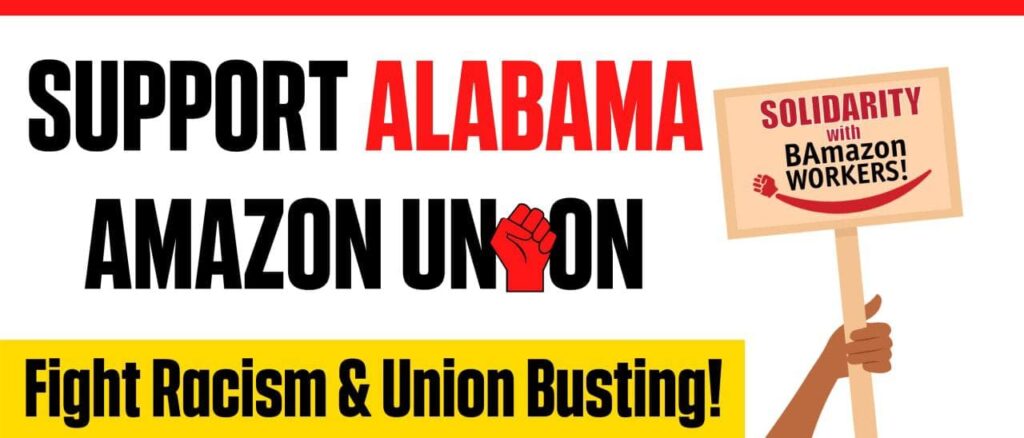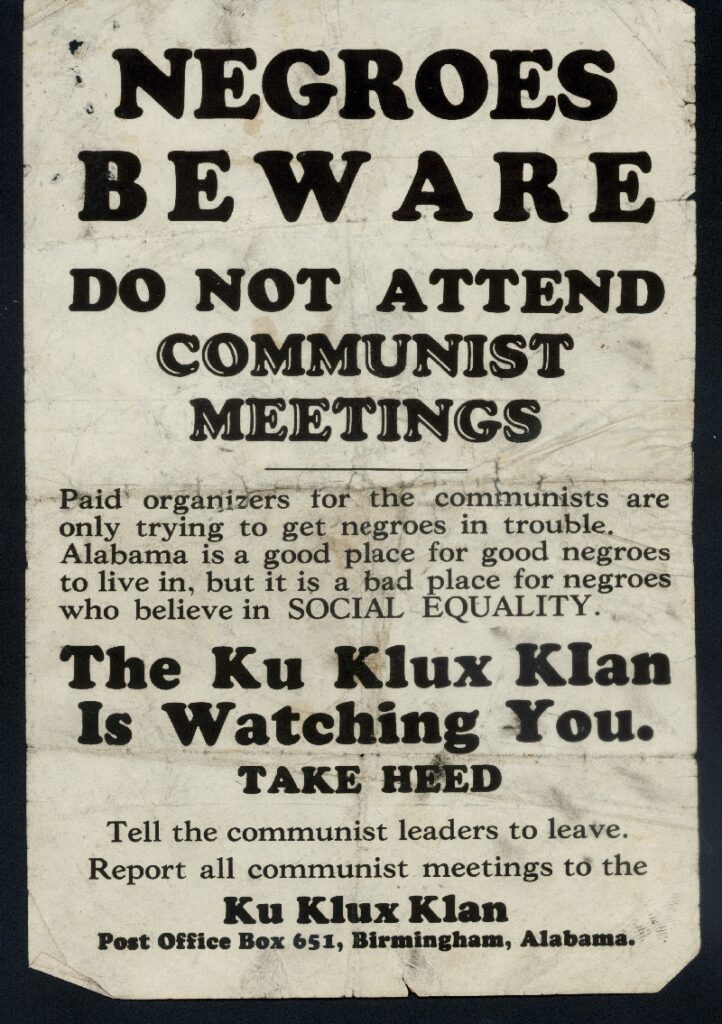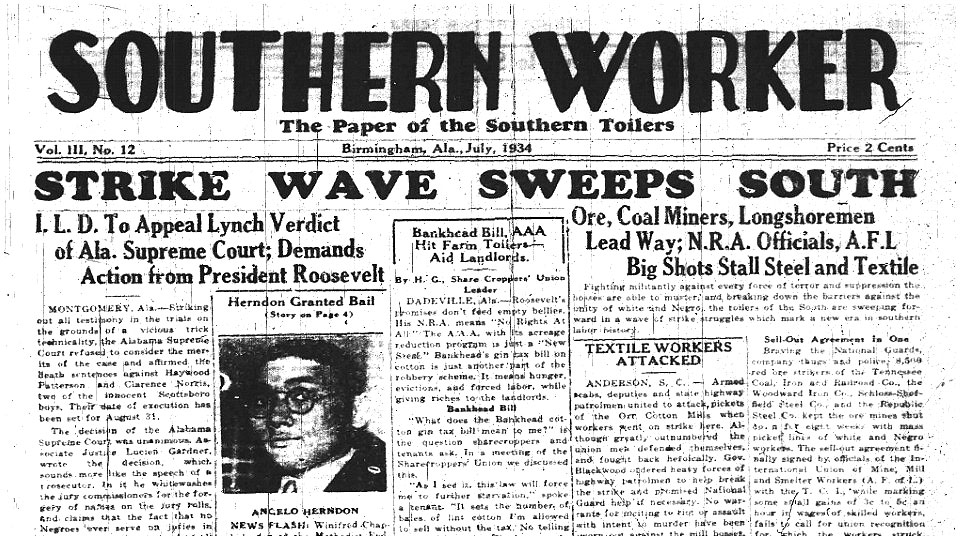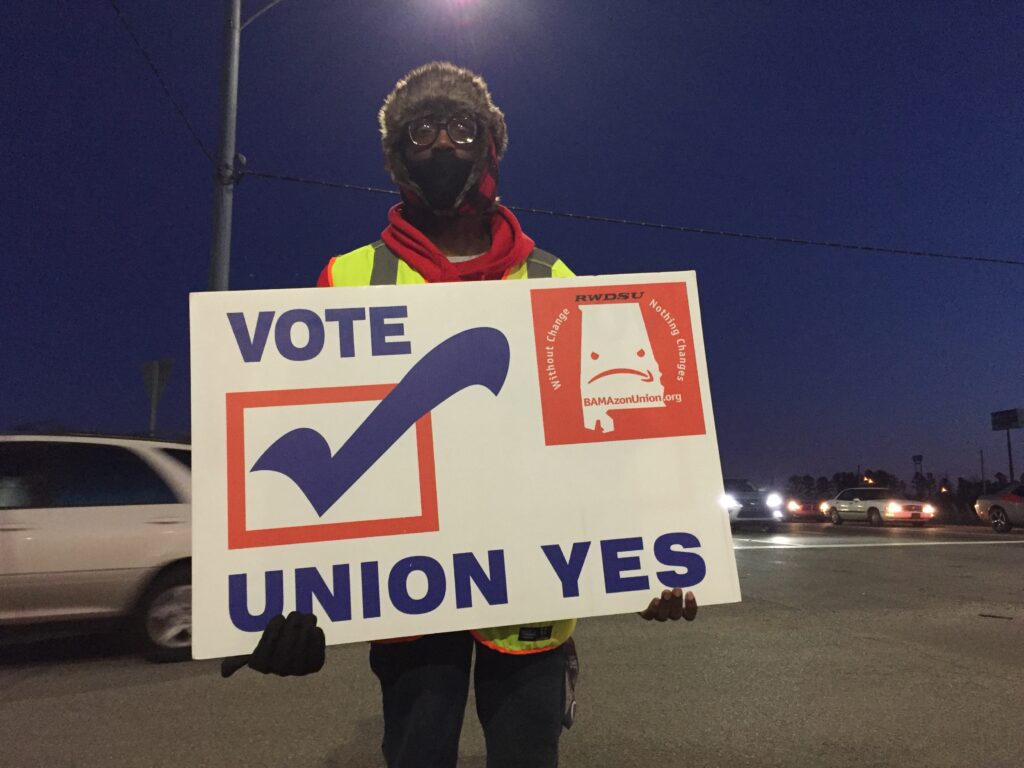Amazon workers and the southern key?
An Alabama song

Arguably the most far-reaching unionization vote in the U.S. thus far in the twenty-first century is set to conclude next month. In the summer of 2020, Bessemer, Alabama Amazon warehouse workers contacted the Retail, Wholesale, and Department Store Union (RWDSU), seeking to join the union. Despite deploying the “gold package” of old anti-union strategies, including all-encompassing surveillance tactics, the company faces a mail ballot vote which will conclude on March 29.
Amazon has allegedly threatened employees if they’re seen promoting the union. Managers are ordering workers to attend thirty minute anti-union “information sessions” during working hours, then forcing them to rush to meet quotas. They are force-fed anti-union messages everywhere from their text messages to the toilet stalls at the facility. Amazon lawyers have made multiple attempts to stall the unionization vote, first insisting it be held in-person despite coronavirus risks.
On the flipside, this campaign has received a deserved breadth of attention and support, from liberal organizations, the NFL Players Association, Bernie Sanders, and the Left across Alabama and nationally, as well as from organized labor. Unionized poultry workers stand outside the Bessamer facility in the mornings, expressing their support for the vote and solidarity with the Amazon workers. Across the board, there is some understanding of both the importance and the incredible challenges of this unionization fight in Alabama.

During the pandemic Amazon has seen huge surges in demand. And though it’s increased its workforce by over 50 percent, workers still face highly stressful working conditions. At the Bessemer warehouse, workers have reported being told to pick over 2,500 items for delivery per day at 8 seconds per item. When they’re unable to reach this rate, supervisors threaten them with demotion or firing. Workers are bound by nondisclosure agreements, restricting them from sharing much about their working conditions. But on Reddit, they anonymously discuss grueling Amazon policies, including new twelve hour stocking shifts called “megacycles.”
Generally, Alabama has been regarded as an “unlikely” place for the e-commerce giant to face a union drive, though there has been talk of unionizing the company for years. Amazon has two facilities in Alabama and spent $325 million on the Bessemer warehouse, bringing 1,500 full-time jobs. Amazon likely thought Alabama, a southern state, was a safe bet in avoiding the pro-union actions of the company’s northeastern locations, given the region’s anti-union tendencies. The fact that it received $41.7 million in tax breaks from the state helped sweeten the deal.
Within the labor movement, for a number of years there have been rumblings about a resurgence of organizing in the southern U.S. At every crescendo of hope, there’s a frenzy of attention, as seen at Amazon now. And there is also the inevitable swift anti-union attack by the company, local and state officials, and sometimes workers themselves. And then the status-quo appears to return.
See, this is the South. Politicians have claimed these jobs were hard to “wrangle in” and they’re the best that workers here could hope for. During the 2017 unionization vote at Mississippi’s Nissan Plant, then-governor Phil Bryant told workers that a Nissan union would “take away your job.” “If you want to end manufacturing as we know it in Mississippi,” Bryant stated, “just start by expanding unions.”
Management and supervisors regularly inundate workers with the same anti-union messages in forced meetings, through company-produced videos, veiled threats, and misleading claims that are now being deployed at Amazon.
This being the South, with its extremely low rate of unionization, workers can be afraid of the unfamiliar. When the UAW came to Alabama’s Mercedes-Benz plant in 2013, some Mercedes employees paid for a billboard on the side of a highly-trafficked interstate. It read: “Just say NO to the UAW. Because Alabama is the home of winners, not losers.” A sixteen-year old employee who pitched in for the sign said “I want Mercedes to be here when I retire … [the UAW is] going to wind up messing things up.”
This offensive strategy by employers has been mostly effective. Multiple large-scale unionization attempts at southern auto plants have been defeated over the past few years. “We just don’t like unions very much down here,” said one worker after a failed Volkswagen vote in Tennessee.
But, as southern industry has grown (in large part due to big corporate tax benefits and un-unionized, lower-paid workforces), there have been more organizing attempts. There is hope thatthe Bessemer Amazon vote may be a signal of an overall shift in southern labor consciousness and a reason for cautious excitement.
The history behind the vote
The significance of this vote is undeniable, but to avoid both an irrational optimism over the next month of the campaign and an unwarranted depression should it fail, understanding the weight of the history is crucial.
That Alabama has the first Amazon facility to hold a unionization vote might come as a surprise. And it is quite unusual, given that it is amongst those states consistently ranked the least-unionized.
Southern states were among the first to adopt right-to-work laws in the late 1940s and 50s, making it optional for non-union workers to pay dues at unionized workplaces. Crafted by a rabidly segregationist and antisemitic Texan conspiracist, right-to-work laws were explicitly advertised to maintain racial separation in the workforce and white supremacy through preventing unionization.
Right-to-work as well as other anti-labor policies have spread across the U.S., including the former labor strongholds of the Midwest. The blame for this nationwide shift in labor relations is sometimes placed on the South, as it fostered, honed, and grew anti-labor policies. In turn, the “social backwardness” of the South’s politicians and populace are blamed for this.
But southern labor history is complex. Movements for workers’ rights—like what’s happening in Amazon—have bubbled up repeatedly and were sometimes even radical in nature. They’ve simply been quashed and suppressed more effectively than those in the North. It wasn’t necessarily the culture of the South that created its anti-labor environment, but rather, specific historical and structural dynamics that created the condition for anti-labor politics to be instrumentalized. This, in turn, created this current culture.
The breadth of the spectrum of people involved in early southern organized labor movements cannot be overstated. In Alabama, for example, members of the Ku Klux Klan and communist organizers were both active during the state’s industrial era in the first part of the twentieth century. But the Klan, of course, was only pushing for the rights of a certain, very small, subset of white workers, actively working to suppress the rights of Black and immigrant workers. Their efforts to stoke division in labor organizing were a great aid to the industrial capitalists they later allied with, especially in the steel industry. They had much of the same goal – divide and conquer.

Alabama Communists, on the other hand, were a small, ragtag group, often working underground, according to Robin Kelley’s account of them in Hammer and Hoe. When the effects of the Great Depression ravaged the state, the Alabama Communist Party organized the unemployed and tenant farmers, the majority of them Black, to fight for relief. From the late 1920s, in urban areas like Birmingham, the Alabama CP played a crucial supportive role to the growing miners’ and steel unions. And Black members were at the forefront of the party, especially given its central message of racial solidarity, equality, and focus on rural farmers as well as urban workers.
The Alabama CP later worked with some of the northern labor organizers that descended upon the South. Northern organizers were often unsure about where to begin in the South. Many had downplayed its potential within the national labor movement. But they were also baffled by the strength and numbers of some of the region’s unions, especially in Alabama.
Michael Goldfield, author of The Southern Key, notes many instances of “Alabama Exceptionalism” in the southern labor movement. In recounting the history of southern labor, he emphasizes the importance of Alabama’s coal and iron ore unions in growing southern organizing.
Mining required high skill and trust in one’s coworkers, as it was extremely dangerous work. It was also a highly racially integrated industry, in Alabama especially. Mining sites tended to be in isolated areas, mostly under the control of a few very large mining companies.
These factors all created conditions ripe for organizing. Mine ownership concentration and the skill required to mine gave workers more leverage and unity than usual. Their structural power (providing crucial resources) was almost unmatched. And while segregationist sentiments lingered among some workers, many knew that if workers could be divided and picket lines crossed, they would have no real bargaining strength. This made miners notable for uniting across racial lines.
For the first few decades of the 1900s, Alabama coal miners became the “vanguard,” taking the initiative to bolster organizing efforts in other southern industries, from woodworkers to washerwomen. They gained political leverage as well, which was rare in the highly stratified South. Goldfield writes that they initiated a wave of union activity in the South as workers in other industries saw for themselves the leverage the unions had.
But while national unions took note of this, their strategies for the South were deeply flawed.
Many had solely white leadership and often alienated and ignored the Black workers that were crucial to labor struggles. This was particularly evident in the CIO’s failure to organize the majority-Black lumber industry, despite its great receptiveness. The CIO tended to ignore Black rural struggles, prioritizing the majority-white textile industry.
However, garment industry organizing was in an uphill battle. National unions like the CIO didn’t have a coherent strategy, and mill owners effectively used divisive racist tactics. Their tactics were often equally flawed, bringing in mostly male, outside organizers to speak to the already guarded, female mill workers, for example.
Racism was undoubtedly the largest hurdle in the overall political economy of the region that contributed to the fate of southern labor.. The pro-labor politicians of the early twentieth century were aberrations in southern politics. Generally, southern politics have been dominated by a semi-oligarchic, quasi-aristocratic order of “planter-industrialists.” Like today, they used the common talking point that pro-business (and anti-labor) stances were the only way to compete with northern states, especially with the decline of southern agriculture. Next, they used their one-party rule to further stoke racial divisions and stamp out labor struggles, sometimes violently.
Those in power secured their rule through concerted efforts to disenfranchise workers through measures like extreme gerrymandering, making it difficult for workers, especially Black workers, to regain their political strength.
The non-diversified nature of southern industry also played a role in weakening workers’ strength. Southern coal and iron ore miners were quite militant, but the largest southern industry—textiles—aced a different fate. Early on, southern textile workers in Alabama carried out several notable strikes, aided by the miners’ unions.

Desperation for work, driven by the rapid collapse of southern agriculture, made interracial unity difficult in the textile industry. White garment workers were threatened by the prospect of hiring Black workers to replace them. Mill owners also had a reserve of poor white farmers to hire as strikebreakers. Mechanization also made it easier to replace any striking workers. The failure to organize the southern textile industry would then have a knock-on effect for the rest of the South.
Generally, the South had a higher concentration of work that did not require specialized training, though it was labor-intensive. This posed a problem for industrial unionists engaged in cross-industry organizing.
In the South, high turnover rates of lower-skilled professions, heightened anti-union propaganda, and fragmented industry made it difficult for industrial unions to take root in the region.
These factors, combined with the strategic weaknesses of the national unions, shrank union presence in the South over the post-war decades despite southern workers fighting back unceasingly against unfair labor practices. Union growth was further stunted by offshoring and deindustrialization which devastated the textile, steel, and mining industries.
The Vote is Historic
The pattern of industrial globalization launched with the neo-liberal era in the 1970s and 1980s has now come around full circle. With recurring unemployment crises, systematic suppression of U.S. manufacturing wages, and weakening labor regulations to “compete” with the poorer countries, some industries have returned to the U.S.—particularly the South. And that brings us back to Amazon.
Many southern states have offered lucrative “megadeals” to companies like auto companies and Amazon willing to relocate or build manufacturing or transport infrastructure. They have entered a race to the bottom in offering the sweetest deals to potential employers with gigantic tax breaks, credits, or subsidies. The prospect of non-union workers is also used to tempt employers.
And it’s kind of worked. To avoid tariffs; parts manufacturers, auto makers, and distribution facilities like Amazon’s have sprung up in the South, often in rural areas. In a 2017 Bloomberg investigation, a former OSHA official spoke to this dynamic: “The supply chain isn’t going just to Bangladesh. It’s going to Alabama and Georgia.”
Lawmakers’ concessions to corporations in exchange for job creation rarely take into account if these jobs are of good quality or contribute to higher communal quality of life. Though auto manufacturers in the region have relatively high pay and good benefits, they still don’t measure up to those of northern workers or those in many of the foreign manufacturers’ home countries. Many of the auxiliary auto jobs are known for low training, low pay, and extreme time pressure. It’s well known that Amazon workers face much of the same.
But the rumblings of a new workers’ movement in the South are again getting loud. Knowing the current and past conditions of southern industry and worker organizing is instructive for this future.
The one-party, anti-union politics of the South are largely the same as they were in the past. But this seems to be shifting too. The surprise Democratic party victories in Georgia may be one sign. And though the fight for workers’ rights is largely tied up with the traditions of the Left, these are issues that historically even conservative workers can be won to. Organizer Tiffany Flowers, in an insightful Labor Notes interview on working in the South, touched on this with her experience organizing a small Lipton Tea plant in Virginia. It was an outspoken Trump-loving Republican man who first contacted her to arrange a unionization vote, she said. And his colleagues of differing political opinions agreed with him on this one issue.
To create a strong labor movement, it is essential to not pander to the Right. Relying on Democrats will not serve it either. However, an overall shifting of opinions on workers’ rights could drive the formation of a larger pro-labor consciousness in the South. The Black Lives Matter movement and state and federal government neglect during the pandemic have already rekindled this possibility. It has become easier to recognize the common racial and class dynamics of these struggles.
The infrastructural integration of southern industries could also be critical for industrial organizing that in the past wasn’t successful. Labor scholar Kim Moody sees this as key in organizing not only the South but many logistics hubs.
In addition to tax benefits being a large draw to manufacturers, Moody’s scholarship also points to the “logistics revolution” that concentrates industries in clusters near metropolitan areas. This allows for both the rapid delivery that customers come to expect, as well as cost cutting through “lean production,” i.e. overworking fewer employees. In a trade publication, Alabama was ranked one of the top states for business climate not only because of its “business-friendly” tax structure, but also because of its developing transportation infrastructure.
Clustering in major logistics hubs means millions of dollars of capital investment sunk into infrastructure in specific areas. “The embedded nature of much of this investment … and the frozen routes of movement … means that, unlike individual firms, the major clusters and their links are not able to relocate abroad or even elsewhere in the host nation,” Moody notes.
This gives workers immense structural leverage, not unlike the miners of the past. The monopolization of industries has also reproduced the conditions that eased unionization for miners. Taking advantage of these “chokepoints” through industrial organizing could begin with unionizing giants like Amazon, says Moody and other organizers.

This analysis gives even more weight to the current unionization vote. Bessemer, where the Amazon distribution center is located, also has logistics centers for Lowes, Carvana, Dollar General, Fedex, and multiple auto parts suppliers serving Alabama’s growing auto manufacturing sector. The prospects for extending unionizing drives with a win at Bessemer are real.
There would be other benefits as well. Moody has also written of the renewed push for non-traditional labor organizing strategies. A unionization push across Amazon should give confidence to the workers pursuing these strategies, and create likely allies across the country. Amazonians United (AU), for example, has already begun training and assisting workers in organizing in Amazon facilities across the country in the absence of a union. They have made some major wins through coordinating petitions, walkouts, and protests.
In a Chicago-area Amazon warehouse, DCH1, AU consulted Sacramento Amazon workers and adapted their tactics for the implementation of paid sick time. The Chicago workers were successful in winning not only for their warehouse, but for every Amazon worker in the U.S. Amazon has since retaliated, suddenly announcing in January it would close DCH1. But AU is still active, publicizing Amazon’s extreme callousness in this decision and fighting for accomodations for workers who are now forced to take megacycle hours at other facilities. These are examples of fights which RWDSU should be willing to support.
Unionization is a powerful step in solidifying workers’ rights, but it’s not the be-all and end-all of the fight for workers’ rights. Resilient and adaptive organizations that are thoroughly integrated into the communities they organize are also essential in building a new labor movement.
Labor movements often start unpredictably with one episode, spread rapidly, and return in waves. This has happened before in the South. Kelley points out how before the Alabama CP took up the mantle of defending Black workers’ rights there were groups like the Knights of Labor. And before them were the Reconstruction-era Union Leagues and Black militias.
There are still many barriers to overcome, especially with decades of anti-union fearmongering to unpack. But there’s still a sense of cautious optimism. A spike in organizing, maybe in Bessemer maybe elsewhere, could re-start the inclusive, radical, and multi-racial tradition of southern labor, spreading it outside the region.
Categories
We want to hear what you think. Contact us at editors@tempestmag.org. And if you've enjoyed what you've read, please consider donating to support our work:
DonateSumona Gupta View All
Sumona Gupta is an immigrant rights organizer based in Tuscaloosa, Alabama.
